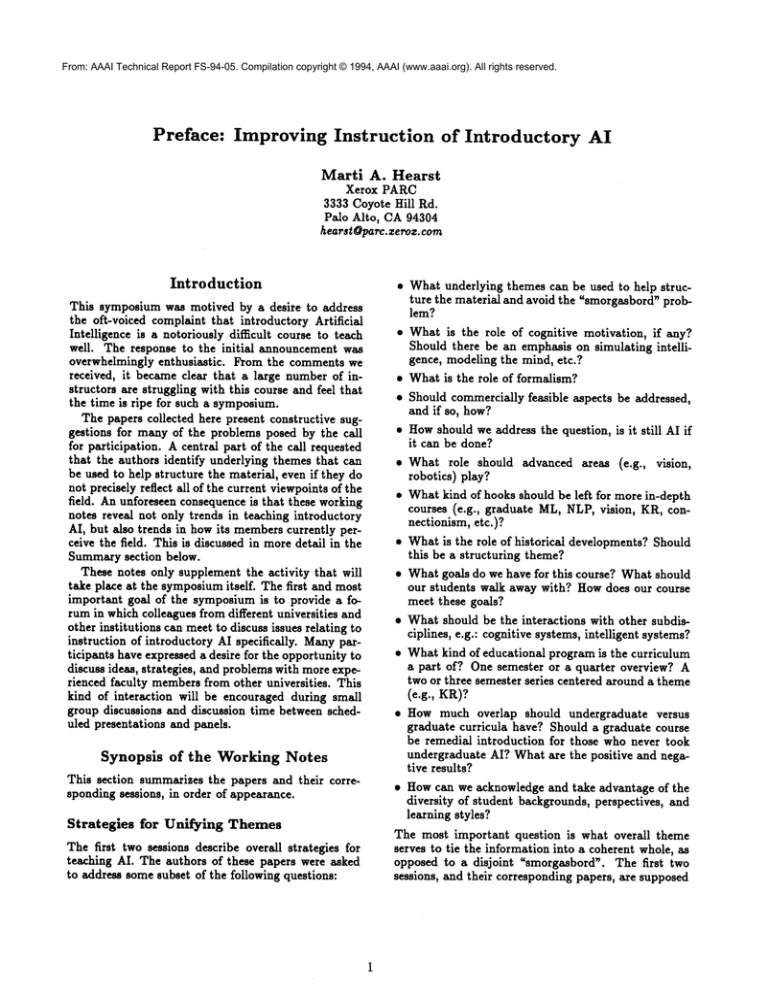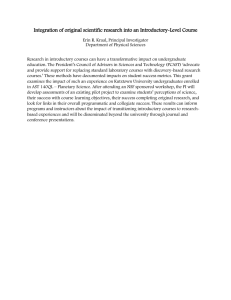
From: AAAI Technical Report FS-94-05. Compilation copyright © 1994, AAAI (www.aaai.org). All rights reserved.
Preface:
Improving Instruction
of Introductory
AI
Marti
A. Hearst
Xerox PARC
3333 Coyote Hill Rd.
Palo Alto, CA 94304
hearst Oparc.zeroz. corn
Introduction
This symposium was motived by a desire to address
the oft-voiced complaint that introductory Artificial
InteUigence is a notoriously difficult course to teach
well. The response to the initial announcement was
overwhelmingly enthusiastic.
From the comments we
received, it became clear that a large number of instructors are struggling with this course and feel that
the time is ripe for such a symposium.
The papers collected here present constructive suggestions for many of the problems posed by the call
for participation. A central part of the call requested
that the authors identify underlying themes that can
be used to help structure the material, even if they do
not precisely reflect all of the current viewpointsof the
field. An unforeseen consequence is that these working
notes reveal not only trends in teaching introductory
AI, but also trends in how its memberscurrently perceive the field. This is discussed in more detail in the
Summarysection below.
These notes only supplement the activity that will
take place at the symposiumitself. The first and most
important goal of the symposiumis to provide a forum in which colleagues from different universities and
other institutions can meet to discuss issues relating to
instruction of introductory AI specifically. Manyparticipants have expressed a desire for the opportunity to
discuss ideas, strategies, and problems with more experienced faculty membersfrom other universities. This
kind of interaction will be encouraged during small
group discussions and discussion time between scheduled presentations and panels.
Synopsis
of the
Working
Notes
This section summarizes the papers and their corresponding sessions, in order of appearance.
Strategies
for
Unifying
Themes
The first two sessions describe overall strategies for
teaching AI. The authors of these papers were asked
to address some subset of the following questions:
¯ What underlying themes can be used to help structure the material and avoid the "smorgasbord" problem?
¯ What is the role of cognitive motivation, if any?
Should there be an emphasis on simulating intelligence, modeling the mind, etc.?
¯ What is the role of formalism?
¯ Should commercially feasible aspects be addressed,
and if so, how?
¯ Howshould we address the question, is it still AI if
it can be done?
¯ What role should advanced areas (e.g., vision,
robotics) play?
¯ What kind of hooks should be left for more in-depth
courses (e.g., graduate ML, NLP, vision, KR, connectionism, etc.)?
¯ What is the role of historical developments? Should
this be a structuring theme?
¯ What goals do we have for this course? What should
our students walk away with? Howdoes our course
meet these goals?
s What should be the interactions with other subdisciplines, e.g.: cognitive systems, intelligent systems?
¯ What kind of educational program is the curriculum
a part of? One semester or a quarter overview? A
two or three semester series centered around a theme
(e.g., KR)?
¯ How much overlapshouldundergraduate
versus
graduate
curricula
have?Shoulda graduate
course
be remedial
introduction
for thosewhonevertook
undergraduate
AI? Whatarethe positive
andnegativeresults?
¯ Howcan we acknowledge
and takeadvantage
of the
diversity
of student
backgrounds,
perspectives,
and
learning
styles?
The most important
questionis whatoveralltheme
serves
to tietheinformation
intoa coherent
whole,as
opposedto a disjoint
"smorgasbord".
The firsttwo
sessions,
andtheircorresponding
papers,
aresupposed
to address this issue in the context of presenting an
overall syllabus for an introductory course.
The first set of papers describes approaches organized around traditional AI concepts. Korf emphasizes
search, knowledgerepresentation, and specialized applications, Epstein & Teller focus on problem solving,
and Ginsberg focuses on a neat, or formal, approach.
Epstein & Teller bring up a point, echoed by Zilberstein, Russell & Norvig, and others, that it is important for students in an introductory AI course to develop at least one project or program that "does something smart," since this gets students excited about
the field.
The next three papers, by Russell &Norvig, Nilsson,
and Zilberstein, describe a new strategy: the agentcentric approach to teaching AI. Wethink this new
viewpoint is exciting, and promising enough to merit
an entire session. In these papers, the unifying theme
of intelligent agents casts the problem of AI as that
of describing and building agents that receive percepts
from the environment and perform actions. Starting
with a simple definition of the agent’s internal states
and behaviors and working towards more complex ones
allows for the gradual introduction of the relevant AI
concepts. In Nilsson’s framework, the simplest agents
have no state and are simply functions that react to
their inputs producing output. In the next step the
agents are given bits of state (making them Turingequivalent if given a infinite numberof bits). This is
followed by a more complex, iconic form of representation. Eventually this progression leads to the incorporation of logic and planning, and language arises from
the need for communication among agents. Other AI
subject areas, such as vision and robotics, can also
be cleanly incorporated into this model, and learning
naturally permeates every level of development (as opposed to being a unit added towards the end of the
course). Additionally, as Russell & Norvig point out,
the agent theme forces the instructor to consider topics that are often ignored or assumed away by other
treatments of the subject matter. One example is the
need to show howgoal-based agents acquire their goals.
The agent theme also brings to light the emerging importance of the distinction between AI as the study
of thought processes and as the study of action and
behavior.
Innovative
Stances
Approaches
and Controversial
The next three papers, corresponding to the next session, present innovative ways to view the task of teaching introductory AI. Batali explores the role of traditional topics associated with AI in the context of a
complete cognitive science program. Batali points out
that the AI approach to cognitive modeling is no longer
the exclusive approach, and that other paradigms
such as dynamic systems theory and neurologicallymotivated models are increasingly important, in part
because they can be more readily aligned to what is
known (incompletely) about the brain and human behavior. Nevertheless, there are conceptual paradigms
that are associated with AI that are important for the
cognitive scientist to knowabout, including symbolic
programming, search, structured knowledge representation, declarative knowledgerepresentation, and constraint propagation.
Martin introduces the notion of "AIgorithms," emphasizing the need to fully integrate AI methods with
that of core computer science, and eradicate the "AI
Ghetto". Martin focuses on using AI problems to motivate the material in computerscience theory courses,
and suggests pointing out the parallels between AI approaches and core computer science. Spector also advocates the use of AI as a structure around which to
organize larger computer science curricula, but suggests a more radical stance in which AI instruction
is distributed in a broad, interdisciplinary curriculum
taught through many courses. (Russell & Norvig also
emphasize the need to link AI approaches to the related areas in computerscience, e.g., linking the students’ knowledge of BNFformalims to that of specifying ATNgrammars. Klassner also emphasizes this
need for integration.)
The next session is a panel entitled "What should
a graduate of AI-101 be expected to know?" Hirsh
frames the problem and will lead the discussion of the
panel. Hayes & Ford have written a position paper
stating, in part, that AI is one of the great ideas of
the century, and urging the instruction of the foundational ideas of the field in order to enable students
to be able to respond to the ideas and arguments of
philosophers and others. They also advocate the importance of weeding out what is historical from what
is important, warning against the "stamped-earthfoundation" theory of the subject. Skinner continues in the controversial framework, suggesting a curriculum oriented toward non-scientists and centered
around non-engineered complex artifacts.
The Role of Programming
The next two sessions focus on issues related to programmingin introductory AI courses. In the call for
participation, contributors were asked to consider the
following questions: Is programming useful or a time
waster? Is it better to use existing tools, or is a compromise - modifying existing programs - better? From
the papers received, the overall consensus seems to be
that programming is very important, and the papers
present several suggestions for howbest to incorporate
programming into the curriculum.
The papers by Eiselt, E. Walker, Goel, and Kumar
& Wyatt address the general programming questions.
Both Eiselt and Kumar & Wyatt suggest a required
companion course that presents a combination of functional (non-imperative) programming,software design,
and basic knowledge representation and data struc-
tures. E. Walker describes the use of computers during
lecture and advocates the generous use of demonstrations of existing systems. Walker emphasizes a balance between existing code and code written by students, and supplies the students with code that can
be easily extended without unduly restricting their designs. Walker also suggests allowing students to work
in groups, but having each report on what parts they
actually programmed. This allows weak programmers
to learn from the design phase but gives proper credit
to those students who invest a large amount of time in
the programmingphase. Goel suggests a design-centric
approach to teaching AI, giving the students interrelated projects that demonstrate the competence and
performance differences of different AI concepts and
methods.
The companion session will include presentations
of repositories
of tools to accompany AI courses,
as well aa two modern, innovative instructional systems. Vaatola & E. Walker present a flexible graphical
tool for teaching reasoning with uncertainty baaed on
Dempster-Shafer theory. M. Walker & 3ordan describe
Design-World, a framework for studying communication among agents, and a testbed for experiments on
the processing limitations of such communicative actions. Papalaakari et. al will describe Flair (Flexible
Learning with an Artificial Intelligence Repository),
repository of educational material and a highly visual
computing environment for use in laboratories associated with the introductory undergraduate Artificial
Intelligence (AI) course. Luger &Stubblefield describe
a repository of basic programs for introductory and advanced AI courses.
Small College
Issues,
Non-American
Approaches,
Other Issues
The next two time periods will consist of "break-out"
sessions, in which the participants choose to join one of
a set of discussions about particular issues. In the first
session, the groups meet and discuss the issue, and in
the second, the results of the discussions are presented
to all symposiumparticipants.
The following session and its corresponding three papers describe issues confronting instruction at smaller
universities and teaching colleges. Danyluk revisits a
topic touched on earlier; that is, the importanceof folding AI into core computer science instruction, but in
this case to attract more students to the field of computer science, mentioning a prior success with a graphics course. Klaasner emphasizes the need to present the
field from a practical viewpoint for students who are
not intending to pursue a PhDin the field, and suggests
a curriculum with the dual goals of making the human
interface to computers anthropocentric and making a
strong link to other computer science courses. Hodgson points out the importance of teaching students how
to tackle poorly specified problems, and suggests the
use of a large, well-structured system that can have
practical applications in the working world.
The final two papers correspond to one of the
"break-out" group topics, describe the state of AI research in two non-American countries. Aiello & De
Rosis describe AI curricula in Italy, and G6mez& Juristo discuss the state of AI in Spain.
Summary
An exciting, unexpected aspect of this symposium is
the emergenceof new attitudes towards the field of AI
as reflected in new strategies for teaching its introductory course. Several themes arise in the contents of
these working notes, and are summarized here.
Beloware listed someof the strategies presented for
fixing the "smorgasbord" problem:
¯ agent-centric
¯ search-centric
¯ focus on formal methods
¯ focus on problem solving
¯ focus around a design science
¯ focus on design of complex artifacts
¯ in the spirit of a liberal arts education
Most striking is the developmentof the agent-centric
theme. This theme allows for the incorporation of some
of the more recent research (e.g., simple agents, models of inter-agent communicationand interaction, etc.)
aa well aa providing a natural framework for folding
in ideas that build upon one another. This works because agents can be described in terms of progressing
from no state to simple state to iconic representations
to more complex representations (including representation of self) to goals to planning to communication,
and so on. Issues that are not central to older texts
but that occupy important positions in research today
(e.g., learning and uncertainty and the role of behavior
in cognition) can be discussed throughout this progression. Thus this new trend in instruction seems to be
reflecting trends in research and in attitudes towards
the field aa a whole.
Another strongly sounded theme is the need to distinguish the old from the important. It is nowa clearly
recognized problem that many AI courses have taught
methods and topics only because they were done long
ago. Several partipants have voiced the need to change
this, and have suggested constructive ways to do so.
Another strong theme is the need to integrate AI
with core computer science, both to increase the use of
AI methods and to enhance interest in computer science. A subtheme is the need to point out when the
two overlap, aa in compiler theory and NLPparsing. A
related subtheme, pointed out by Hayes & Ford, is the
need to integrate AI methods internally aa well. They
use the example that resolution really involves matching and search, for example, and that TMSand theorem proving are related but are usually taught from
different disciplines.
Another theme, focussed around programming issues, is the need to have a project-based orientation
and an emphasis on having students solve open-ended,
non-toy problems. Several participants advocate the
need for a practical approach, while others lay more importance on an understanding of the underlying deep
questions.
Finally, the symposiumhas succeeded in advance in
at least one of its goals; that is in bringing together
people from manydifferent kinds of affiliations.
The
following institutions are amongthose represented by
invited attendees:
BeckmanInstitute,
Urbana, IL
Bryn Mawr College
Cornell University
Georgia Institute of Technology
Hampshire College, Amherst, MA
Harvard University
Hunter College, The City University of NewYork
Information Sciences Institute, Marina del Rey
Knowledge Systems Laboratory
Massachusetts Institute of Technology
McGill University, Montreal
Mitsubishi Electric Research Laboratories
Morgan Kaufmann Publishers
Paris-Sud University, France
Purdue University, West Lafayette, IN
Rensselaer Polytechnic Institute, Troy, NY
Rutgers University
St. Joseph’s University, Philadelphia, PA
Stanford University
Sun Microsystems Laboratories, Chelmsford, MA
Temple University, Philadelphia, PA
Universits’ di RomaLa Sapienza, Italy
University of California, San Diego
University of California, Berkeley
University of California, Los Angeles
University of Colorado, Boulder
University of Florida, Galnesville
University of Geneva, Switzerland
University of Massachusetts, Amherst
University of Michigan, North Campus
University of NewMexico, Albequerque
University of Northern Iowa, Cedar Falls
University of Oregon
University of Pennsylvania, Philadelphia
University of Waterloo, Ontario, Canada
University of West Florida
Villanova University, Villanova, PA
West Chester University, West Chester, PA
Williams College, Williarnstown, MA
Xerox PARC
Acknowledgements
Wewould like to acknowledge the generous support of
NSF, which has provided us with a grant to support
the travel of manyof the workshop’s participants. This
grant is being administered as the Workshop supple-
ment to Lynn Stein’s NYIgrant number 9357761-IILI.
Oscar Garcia of NSF, Lynn Stein of MIT, and Bonnie
Webber of the University of Pennsylvania were instrumental in making this grant come about. AAAIhas
also generously supplied extra funds in support of this
symposium.


